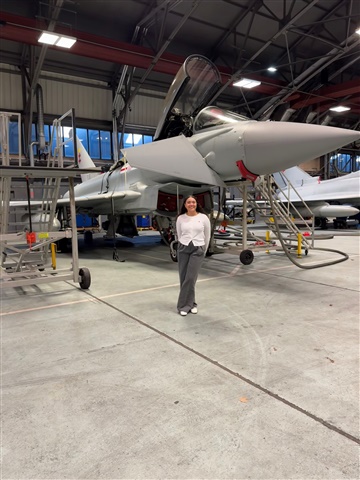New statistics released by The Association of Apprentices (AoA) have confirmed that apprentices working in industry have reported significant personal growth (78%), additional training opportunities (66%), and increased confidence (62%) as key benefits of their apprenticeships.
This upward trend is being reflected in the career success of Luton’s Elin Esnard, even though she only completed her apprenticeship just over a year ago.
Senior Systems Technician Elin Esnard had no idea that she could turn her passion for aviation into a full-time career when she first took up her apprenticeship at global security company Leonardo.
But now she is regularly taking to the skies to test equipment that protects RAF Typhoons which defend UK air space from rogue aircraft, as part of the UK’s Quick Reaction Alert.
Elin said: “The reason that I got into engineering in the first place is because I love planes. I remember on my 16th birthday, my Dad asked me what I wanted to do and I asked him if we could go get KFC and go up to the airport and watch all the planes. I wanted my pilot’s licence and my Mum got me flying lessons for Christmas to see if I actually liked it, because I’d never flown in a plane before. I flew the plane for an hour and when I came back, I was physically on the ground, but emotionally and mentally, I was still in the clouds. It was amazing. I loved it.”
After completing her apprenticeship at Leonardo, Elin was given a placement in the systems integration department. The systems integration department is responsible for carrying out trials and tests on software, hardware, and firmware systems for aeroplanes. Firmware systems are used to connect software to hardware, so that the systems are interconnected and run smoothly.
Elin soon learned that her particular team was going to carry out its first product development flight trials in 20 years, to trial a new protective system for the Typhoon on a light aircraft.
Since then, Elin has been working as part of a wider Leonardo test team that regularly tests equipment in a live flight trial environment, to simulate real world usage of the technology with live readings of its performance.
 Describing a recent test flight, Elin said: “Because I work in system integration, I take the whole system, put it together and test it in a lab in a simulated real-life environment. We took a brand-new kit that had never flown on an aircraft before and merged it with another system for the first time. We designed a brand-new test harness that we fitted to the aircraft so that we could test this new iteration of the system. It was so interesting setting it all up from scratch on a light aircraft, then flying it around the country.”
Describing a recent test flight, Elin said: “Because I work in system integration, I take the whole system, put it together and test it in a lab in a simulated real-life environment. We took a brand-new kit that had never flown on an aircraft before and merged it with another system for the first time. We designed a brand-new test harness that we fitted to the aircraft so that we could test this new iteration of the system. It was so interesting setting it all up from scratch on a light aircraft, then flying it around the country.”
“The way I describe it to my friends and family is, imagine this plane is flying around in a hostile environment. We have to detect what the threat is, where it is located and how fast it is coming towards us. And then we will basically protect the plane, by sending out a signal to indicate that it is located somewhere else.”
In autumn last year, Elin worked as part of a core test team to develop specific radar technology and trial tests for the first flight of the ECRS Mk 2 radar for the Eurofighter Typhoon at BAE Systems’ manufacturing and assembly facility at Warton. Elin also worked with the team to carry out detailed data analysis throughout the trial so that they could produce a detailed report on its performance.
Elin witnessed the Typhoon take off and from the airfield on the ground, while viewing live data feeds coming from the plane.
Speaking about being part of this engineering milestone, Elin said: “It was pretty cool to watch this is a brand-new radar system that we've never flown before fitted to a Typhoon. You’re in this little room and you've basically got all the live feed from the aircraft. So you can see exactly what the pilot is seeing out of their window. So we carried out a more detailed analysis of an extra data feed that the pilot didn’t see and this is how we find out how the kit is responding and working in real life and we can see all of the analytics. You feel a bit like you’re working for NASA, as you’ve got your head set on and you’re talking to the pilot directly in the plane. I think that's why it was so surreal for me, because after a while you feel like you’re in the aircraft with the pilot.”
If you would like to learn more about apprenticeships at Leonardo, please visit: https://careers.uk.leonardo.com/gb/en/early-careers/apprenticeships